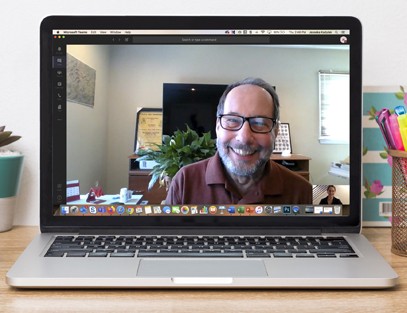
A lot of us are spending considerable time on camera these days.
Maybe not Dr. Fauci-quality time, where we’re imparting crucial information to millions of people. Still, we’re going about our professional life from home and finding Skype, Zoom, and other forms of video conferencing to be a good way for connecting more directly with clients and colleagues than we can by audio-only phone calls.
It’s easy to stop caring how we look when working remotely, but don’t fall into habits like wearing PJs or a ragged sweatshirt with a basket of dirty laundry behind you when teleconferencing.
Here are a few things you can do with little effort to come across the way you know you want to, so that little camera on your laptop can be more of a blessing than a curse.
What’s behind you matters: As I said, keep your laundry out of the picture. If you’re in cramped quarters, you might have few choices but make the best of what you have. A not-too-busy background keeps the focus on you and what you have to say, so avoid nick-knack shelves behind you or anything else that has a lot of intricate items or designs. A bright wall is fine, as are plants. And for a reason I’ll mention next, don’t sit with your back to the window.
Get the light right: A window behind you causes back lighting (quite literally, it lights your back), and makes your face look like nighttime. If that’s the only location you have, close the shade or blinds. Better, sit with that window in front of you. Natural light is the camera’s friend. Better still, add a lamp – placed just behind your laptop. Decent lighting shows your facial expressions and illuminates your presence in an upbeat, credible way.
Here’s looking at you, kid: In person, you look people in the eyes, but the placement of laptop cameras works against that. Usually, on camera people are looking up or down. My solution is to sit my laptop on a sturdy box about 10 inches high. Now I‘m looking directly into the camera so people can see my full face and a bit of my upper body. If you’re showing only face, move back a little. Being too close can exaggerate your nose. Last point here (and often hardest to follow) – when you speak, look at the camera — not the screen. That way, your audience will feel you’re looking right at them.
Don’t be a slouch: This is the same advice I give to people being interviewed on TV. When you lean back in your chair, you not only look less credible, but you also tend to sound a little lazy. Best to sit on the edge of the seat with one leg positioned a little ahead of the other. If you’re like me and enjoy chairs that swivel, either replace them when you’re on video or force yourself not to move. Imagine what your motion looks like to people on the other end; not good.
Wardrobe, please: Now that I’ve gotten you off sweatshirts or jammies, take it one more step and wear what you’d wear at work if your work is business casual – at least from the waist up. Nothing fancy, mind you, but tops in earth tones, saturated colors, or muted blue work well. Busy patterns can create odd and distracting effects on screen, so avoid them.
Now, you’re ready for your closeup.
Related articles:
• Balance Matters: 6 Tips for Working From Home
• Working Through Coronavirus: Tips for Mastering Conference Calls, Virtual Meetings
A photo by freepik was used to create the image for this article.


